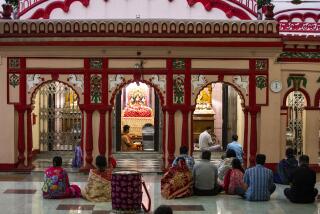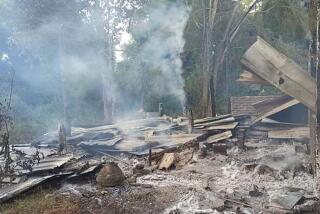They’ve been persecuted by the government for years. Now, some of Myanmar’s Rohingya are taking up arms
- Share via
Myanmar’s western state of Rakhine, where the majority of the country’s Rohingya Muslims live, has seen a wave of violence in recent months. Armed men attacked three border guard outposts on Oct. 9, killing nine police officers. A crackdown by security forces followed that reportedly included killings, rapes and widespread destruction of Muslim villages.
The country’s estimated 1 million Rohingya are not considered citizens and are referred to pejoratively by the government as “Bengalis.” Human rights organizations say the government has disproportionately used violence and committed human rights abuses against the minority group. The government says it is conducting a campaign of counterinsurgency.
Now complicating matters is a finding by the International Crisis Group that a militant Rohingya organization with ties to individuals in Saudi Arabia and Pakistan was behind the recent border guard attacks and represents the face of a new armed insurgency by Muslims in Rakhine state.
“The emergence of this well-organized, apparently well-funded group is a game changer in the Myanmar government’s efforts to address the complex challenges in Rakhine state,” said the report by the International Crisis Group, a conflict research organization based in Brussels.
The violence directed by Muslims against government forces in the October attacks and subsequent clashes was unprecedented, the report said. It showed a previously unseen capacity for planning and coordination and also represented a dramatic twist in the story of the Rohingya in Myanmar.
The armed group, which calls itself Harakah al-Yaqin (“Faith Movement” in Arabic) but is also known to government officials as Aqa Mul Mujahidin (“Communities of Fighters”), does not appear to be motivated by a jihadist terrorist agenda, according to the report. It appears to be focused instead on ending persecution of the Rohingya and securing greater rights for them within Myanmar. However, the report warned that the Rohingya could become further radicalized or have their cause taken up by extremist groups to serve their own agendas if the Rohingya continue to be mistreated by the government.
Analysts from the International Crisis Group interviewed six members of Harakah al-Yaqin and several others with connections to it, as well as Rohingya refugees and members of the diaspora. They also analyzed the group’s communications.
They found that the group is led by a committee of about 20 Rohingya emigres headquartered in Mecca, and commanded on the ground in Myanmar by about 20 more Rohingya from Saudi Arabia who have international training in modern guerrilla tactics. They also found that the group sought and obtained fatwas, or religious rulings, from Islamic clerics in Saudi Arabia and Pakistan, among others, and appears to have received funds from private donors in Saudi Arabia and the Middle East.
More than 100,000 Rohingya Muslims live in camps for the displaced in Myanmar, where they have little access to humanitarian aid, and few opportunities to speak with journalists or human rights organizations. Hundreds of thousands more live just over the border as refugees in Bangladesh, as well as in Malaysia and Indonesia.
Despite their history of persecution, the Rohingya have not engaged in armed conflict against the government, unlike many of the other ethnic minorities in Myanmar, experts say.
“Of all the ethnic groups in Burma, the Rohingya are one of the ones that have been least likely to take up arms,” said Simon Billenness, executive director of the International Campaign for the Rohingya. Myanmar is also known as Burma, the name preferred by pro-democracy activists who contest the legitimacy of the military junta that changed the name in 1989.
When three Rohingya men were convicted of the rape and murder of a Buddhist woman in 2012, a series of violent clashes between Buddhists and Muslims exploded in Rakhine, prompting a brutal crackdown by government security forces on the Rohingya. Human Rights Watch called the crackdown “ethnic cleansing.”
The violence eventually subsided, but in 2015 the Rohingya were forbidden to vote in general elections and lost a major escape route out of the country with the shutting down of migration pathways to Malaysia.
This is new territory for everybody looking at this.
— Brad Adams, Asia director for Human Rights Watch
All of these factors combined to spur the creation of Harakah al-Yaqin and cement its resolve to launch an insurgency, the International Crisis Group said in its report.
Ata Ullah, one of the group’s leaders on the ground, is believed to have attended a six-month Taliban training course in Pakistan shortly after the 2012 violence. Active recruitment and training of local leaders and villagers in Myanmar took place in 2013 and 2014, the report said.
Villagers were organized into cells to make it more difficult for the government to infiltrate the organization. Training, which took more than two years, was led by Rohingya veterans and Pakistanis or Afghans with recent fighting experience and included weapons use and guerrilla tactics, with a focus on IEDs and other explosives. Planning and communication were done mostly over encrypted chat apps, including WhatsApp and Viber.
Observers said it was only a matter of time before at least some Rohingya took up violence. “When you are killing them and burning down their houses and don’t recognize their citizenship and persecute them based on their religion, it’s no surprise,” said Brad Adams, Asia director for Human Rights Watch.
“The Burmese army, by meting out this collective punishment on Rohingya communities, risks radicalizing the Rohingya in a way that we’ve not seen before,” Billenness said. “The responsibility for that lies with the Burmese army.”
Adams said the report provided the clearest picture yet of what happened in the October and November attacks, but it was only “a starting point” for research.
“This is new territory for everybody looking at this,” said Adams. It was clear the attacks had been organized and planned, probably from outside the local community, but more investigation was needed of the composition and scale of the armed insurgent group, he said.
Both Billenness and Adams feared the violence would legitimize further crackdowns by Myanmar’s security force. In two recent reports, Human Rights Watch compiled witness accounts of the government crackdown following the October attacks, and cited satellite imagery that shows the burning of at least 1,500 buildings in Maungdaw township, where the clashes occurred. The government had previously accused the Rohingya of burning down their own homes, but the Human Rights Watch evidence, Adams said, clearly refutes that.
See the most-read stories in World News this hour »
The U.N. estimates that 30,000 people, most of them Rohingya, have been newly displaced internally and largely cut off from humanitarian aid as a result of the conflict; a further 50,000 are estimated to have fled to Bangladesh.
Any army use of the International Crisis Group report to rationalize additional harsh measures would be counterproductive, its authors wrote. Continued misuse of military force, the report warned, “could create conditions for radicalizing sections of the Rohingya population that jihadist groups might exploit for their own agendas.”
Twitter: @AgrawalNina
MORE WORLD NEWS
Nuclear experts to Trump: More than tweets are needed to stop North Korea
More to Read
Sign up for Essential California
The most important California stories and recommendations in your inbox every morning.
You may occasionally receive promotional content from the Los Angeles Times.











